
The V-1 flying bomb was an early cruise missile. Its official Reich Aviation Ministry (RLM) designation was Fi 103. It was also known to the Allies as the buzz bomb or doodlebug and in Germany as Kirschkern or Maikäfer (maybug).

A jet aircraft is an aircraft propelled by jet engines.
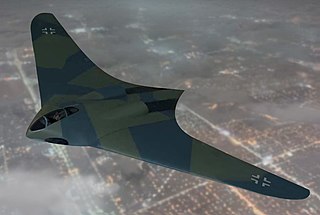
The Horten H.IX, RLM designation Ho 229 was a German prototype fighter/bomber initially designed by Reimar and Walter Horten to be built by Gothaer Waggonfabrik. Developed at a late stage of the Second World War, it was the first flying wing to be powered by jet engines.
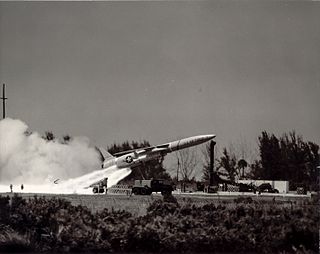
The Northrop SM-62 Snark is an early-model intercontinental range ground-launched cruise missile that could carry a W39 thermonuclear warhead. The Snark was deployed by the United States Air Force's Strategic Air Command from 1958 through 1961. It represented an important step in weapons technology during the Cold War. The Snark was named by Jack Northrop and took its name from the author Lewis Carroll's character the "snark". The Snark was the only surface-to-surface cruise missile with such a long range that was ever deployed by the U.S. Air Force. Following the deployment of ICBMs, the Snark was rendered obsolete, and it was removed from deployment in 1961.

The Henschel Hs 132 was a World War II dive bomber and interceptor aircraft of the German Luftwaffe that never saw service. The unorthodox design featured a top-mounted BMW 003 jet engine and the pilot in a prone position. The Soviet Army occupied the factory just as the Hs 132 V1 was nearing flight testing, the V2 and V3 being 80% and 75% completed.

The Northrop YB-35, Northrop designation N-9 or NS-9, were experimental heavy bomber aircraft developed by the Northrop Corporation for the United States Army Air Forces during and shortly after World War II. The airplane used the radical and potentially very efficient flying wing design, in which the tail section and fuselage are eliminated and all payload is carried in a thick wing. Only prototypes and pre-production aircraft were built, although interest remained strong enough to warrant further development of the design as a jet bomber, under the designation YB-49.

The Northrop YB-49 was an American prototype jet-powered heavy bomber developed by Northrop Corporation shortly after World War II for service with the United States Air Force. The YB-49 featured a flying wing design and was a turbojet-powered development of the earlier, piston-engined Northrop XB-35 and YB-35. The two YB-49s actually built were both converted YB-35 test aircraft.

The Consolidated Vultee XP-81 is a development of the Consolidated Vultee Aircraft Corporation to build a single seat, long range escort fighter that combined use of both turbojet and turboprop engines. Although promising, the lack of suitable engines combined with the end of World War II doomed the project.
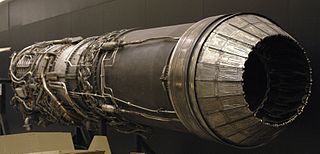
The General Electric J79 is an axial-flow turbojet engine built for use in a variety of fighter and bomber aircraft and a supersonic cruise missile. The J79 was produced by General Electric Aircraft Engines in the United States, and under license by several other companies worldwide. Among its major uses was the F-104 Starfighter, B-58 Hustler, F-4 Phantom II, A-5 Vigilante and IAI Kfir.

The North American SM-64 Navaho was a supersonic intercontinental cruise missile project built by North American Aviation (NAA). The final design was capable of delivering a nuclear weapon to the USSR from bases within the US, while cruising at Mach 3 at 60,000 feet (18,000 m) altitude. The missile is named after the Navajo Nation.

The Northrop XP-79, USAAF project number MX-365, was rocket and jet-powered flying wing fighter aircraft, designed by Northrop. The pilot operated the aircraft in a prone position, permitting him to withstand much greater g-forces in pitch. It also used a welded magnesium monocoque structure instead of riveted aluminum.
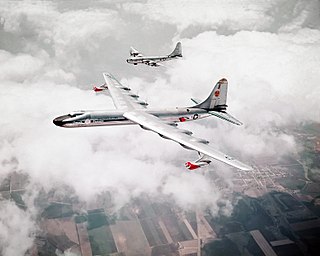
A nuclear-powered aircraft is a concept for an aircraft intended to be powered by nuclear energy. The intention was to produce a jet engine that would heat compressed air with heat from fission, instead of heat from burning fuel. During the Cold War, the United States and Soviet Union researched nuclear-powered bomber aircraft, the greater endurance of which could enhance nuclear deterrence, but neither country created any such operational aircraft.

The General Electric J85 is a small single-shaft turbojet engine. Military versions produce up to 2,950 lbf (13.1 kN) of thrust dry; afterburning variants can reach up to 5,000 lbf (22 kN). The engine, depending upon additional equipment and specific model, weighs from 300 to 500 pounds. It is one of GE's most successful and longest in service military jet engines, with the civilian versions having logged over 16.5 million hours of operation. The United States Air Force plans to continue using the J85 in aircraft through 2040. Civilian models, known as the CJ610, are similar but supplied without an afterburner and are identical to non-afterburning J85 variants, while the CF700 adds a rear-mounted fan for improved fuel economy.
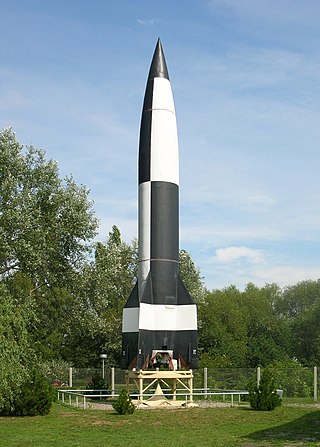
Wunderwaffe is a German word meaning "wonder-weapon" and was a term assigned during World War II by Nazi Germany's propaganda ministry to some revolutionary "superweapons". Most of these weapons however remained prototypes, which either never reached the combat theater, or if they did, were too late or in too insignificant numbers to have a military effect.

The Argus As 014 was a pulsejet engine used on the German V-1 flying bomb of World War II, and the first model of pulsejet engine placed in mass production. License manufacture of the As 014 was carried out in Japan in the latter stages of World War II, as the Kawanishi Maru Ka10 for the Kawanishi Baika kamikaze jet.
The Fairchild J83 turbojet was developed starting in 1955 to power cruise missiles used as un-armed decoys for bomber aircraft. The engine's development was terminated in November 1958.
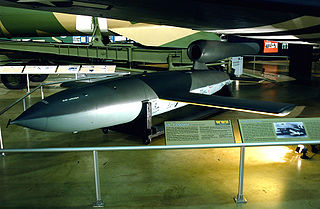
The Republic-Ford JB-2, also known as the Thunderbug, KGW and LTV-N-2 Loon, was a United States copy of the German V-1 flying bomb. Developed in 1944, and planned to be used in the United States invasion of Japan, the JB-2 was never used in combat. It was the most successful of the United States Army Air Forces Jet Bomb (JB) projects during World War II. Postwar, the JB-2 played a significant role in the development of more advanced surface-to-surface tactical missile systems such as the MGM-1 Matador and later MGM-13 Mace.

The JB-4, also known as MX-607, was an early American air-to-surface missile developed by the United States Army Air Forces during World War II. Using television/radio-command guidance, the JB-4 reached the flight-testing stage before being cancelled at the end of the war.

The XSSM-A-5 Boojum, also known by the project number MX-775B, was a supersonic cruise missile developed by the Northrop Corporation for the United States Air Force in the late 1940s. Intended to deliver a nuclear warhead over intercontinental range, the project was determined to be too ambitious given technical difficulties with the SM-62 Snark which it was planned to follow, and it was canceled in 1951.
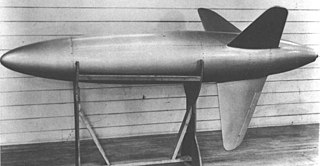
The JB-3 Tiamat was subsonic air-to-air missile program that began in January 1944 for the U.S. Army Air Force under project MX-570. Prime contractor was Hughes Aircraft Company Electronics Division which developed the Tiamat with the assistance of the National Advisory Committee for Aeronautics, (NACA). Tiamat was propelled by a rocket motor of a boost-sustain dual-thrust type, providing 7,200 lbf (32 kN) of thrust for 3.5 seconds, followed by 200 lbf (0.89 kN) for 45 seconds of cruising flight at 600 miles per hour (970 km/h). Tiamat used semi-active radar homing radar guidance to intercept the target aircraft, with a proximity fuze to detonate the missile's 100 lb (45 kg) High Explosive warhead when within lethal range of an enemy aircraft. The JB-3 program was quickly reduced in status following the end of WWII. Testing by the NACA and US Army Air Force continued into 1946. Though the project was cancelled due to ongoing problems, missiles already under construction were used by the National Advisory Committee for Aeronautics for research during the next few years. During the program considerable research was conducted including a radical modification to the aerodynamic design testing swept wings. Existing during a period from where anything was tried, to limited development funding, the JB-3 had proven the limits of existing technology as well as providing much experience. With the appearance of more promising missile designs the JB-3 had gone from the cutting edge of technology to obsolete in just a few years time.




















